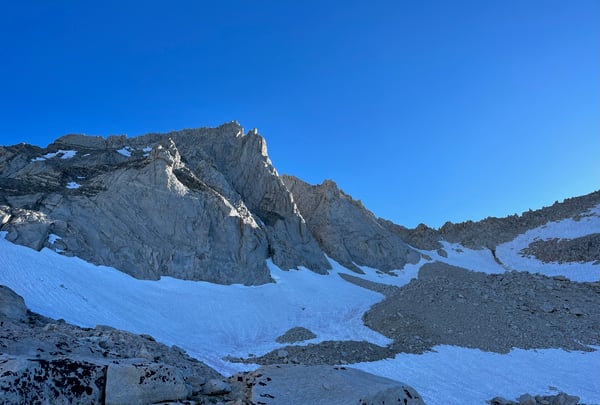The capstone of my summer of funemployment was to be a two week long trip to the Sierra Nevada, one of my favorite mountain ranges. The Sierra has a special place in my heart. It was where I discovered mountains as an adult and where I returned during my previous two summers off on either side of grad school. While the Cascades had dominated my mountain dreams for the past five years, my interest in the Sierra was rekindled when Sally decided to do the Sierra High Route last summer. I had too many plans for my meager time off from work to join that trip, but I dreamed and schemed obsessively. Dan and I managed to stop by the Sierra for a short time as part of a larger fall trip that year, the bright yellow aspens unexpectedly gorgeous. We didn’t have any climbing or backpacking gear but managed to fit in three short day hikes. It was enough to stave off my hunger for the range of light. But alas, I contracted Covid in the middle of the trip and became miserable. Unfortunately the symptoms of altitude sickness and Covid are quite similar, so I didn’t realize I was infected until we were scheduled to fly out. I crossed my fingers for better health this time around.
My original plan was to join Sally for a section of the Sierra High Route, a mostly off-trail non-technical traverse of the range, but she bailed at the last minute, leaving me scrambling (no pun intended) to make plans. I had wanted to experience more alpine climbing in the Sierra for many years, having only done a few ultra classic routes like the East Buttress of Mount Whitney and the Red Dihedral on the Incredible Hulk. I knew there was so much beautiful white granite out there to explore. But I also wanted to see more of the range like I would have done on the high route. Out of this dilemma came a crazy idea. And one partner immediately came to mind for a big, crazy adventure at the last minute - Lei. Characteristically, she was immediately in.
I looked up some of the climbs on my five-year-old Sierra list, searching for an area where we might be able to climb something and also do a section of the high route. Perhaps two climbing areas could even be connected by the high route itself? Bear Creek Spire fit the bill. A beautiful, classic, moderate climb mere miles from the high route. We could approach the standard way through Little Lakes Valley, do the climb, and descend to the west to meet up with the high route. Nominally there was a trail starting at Lake Italy, but as we were to find out, this designation was generous. After Italy Pass we would end up in an area called Granite Park, which looked beautiful with towering peaks, smooth slabs, and alpine lakes. I thought maybe we could fit in a another easy climb in the Royce Lakes Basin on the way out. Wow, was that overambitious.
Climbing and high routing are in many ways the antithesis of one another. There is a reason why no one tries to combine them. High routing is the epitome of ultra-light backpacking. Essentially taking the slowest way through the most difficult non-technical terrain possible, it requires the ruthless casting off of any excess weight not strictly required for survival, especially if one is a mere mid-30’s casual outdoorswoman hoping to complete routes pioneered by alpine hard men and frequented by wilderness ultramarathoners. Climbing, on the other hand, requires a huge amount of heavy metal gear for mere mortals wishing to stay alive for many decades to come. While many climbers, myself included, would prefer a 16 hour day to carrying camping gear in addition to climbing gear, sometimes camping overnight is warranted for long routes. A typical strategy is to complete a long and strenuous approach the day before a climb and set up camp at the base. Then the technical part of the climb can be completed without the added burden of overnight equipment. However if one were to exit a different route than one came from, everything would have to be carried on the climb or ferried around the technical difficulties, significantly adding to either technical or logistical difficulty, or perhaps both, as I would soon find out.
I quit my job because I felt like there were too many other things that I wanted to do in my ever receding time left on this earth. And still, circumstances lent me barely enough time to do anything. I realize now that it will always be this way, whether I am constrained by a full time job or not. No matter how much time I have, I will always want more. I will always cram as much adventure and newness possible into every trip, often going beyond what is enjoyable or even reasonable to what is physically possible. Sometimes regrettable (how much more would I appreciate my time in nature if I stopped to relax?) but inevitable, the fate of the obsessed.
A bizarrely out-of-place tropical storm prevented me from getting down to the Sierra as early as originally planned, leaving only 9 days for the mountains plus two days of driving on either side. After spending many days searching for permits, planning, and searching for permits again, I had an itinerary in hand and partners lined up. Dan would drive down with me and join for the first 3 day backpacking trip, then I would meet up with Lei for another 5 days of climbing, including my crazy/dumb idea for a climb of the ultra classic, 13,700 ft high North Arete of Bear Creek Spire, followed by an usual exit where we would cover part of the Sierra High Route, pass by some gorgeous alpine lakes, and maybe tick off another climb. Dan graciously agreed to ferry us to our exit trailhead, where we would leave Lei’s car, and drop us off at the typical approach for Bear Creek Spire at Little Lakes Valley.
The mood was tense as we wound up and up to the Pine Creek trailhead, where we would end our route three days later. The landscape around this trailhead was very uncharacteristic of the Sierra. I gawked at a colorful, dramatically steep canyon and wondered where the trail could possibly go. I didn’t find out since we were already an hour behind schedule and sunset was imminent.
Packing was the first major challenge. Not only did we have to carry all our climbing gear, camping gear, and food for three days, but we had the added complication that all three of us, our packs, and all the other crap we brought on the road trip would have to fit in one car. Considering that both of our two cars were close to capacity, this turned out to be rather more difficult than I had imagined. Or should I say, did not imagine because honestly, I didn’t think about it until Dan brought it up. We parked next to a colossal pine tree and exploded everything out of our car onto the gravel lot. As we packed, a pair of climbers emerged from the trail looking absolutely wasted. We didn’t say anything to them. After almost an hour of organizing and reorganizing, Dan looked down skeptically at the size of our backpacks. We lifted them tenuously, unsure if we could wear them for 10 minutes let alone three days across unknown terrain. I was already at a low point of self-belief, and our trip hadn’t even started yet. We haphazardly transferred some bags to Lei’s car and were off.
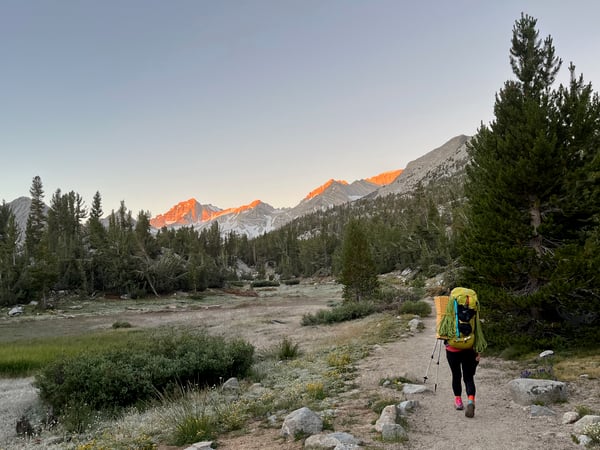
The next day’s hike started out acceptably enough. I think we left almost an hour after our intended time but we had been conservative, so I thought we would still be on track to complete the climb that day. It took us longer to get to Dade Lake than I had expected, partially because of minor route-finding issues and partially because Lei seemed to be on a super leisure speed. I knew we were running out of time. I quickly set up our tent and repacked my gear for the climb while Lei caught up with me. To my dismay the next thousand feet or so of elevation went painfully slowly. We slogged up ridiculously sun cupped steep snow, the concavities often reaching past my knees. Lei was really struggling with the altitude as I looked back at her impatiently.
Finally the hour arrived when we needed to call it. It felt like defeat to admit that there was just no way we would be able to finish the climb and descend before dark, especially given that the terrain between the climb and our next camp was completely unknown to us. Ironically it was this admission that allowed us to complete our objective in the end.
The year’s record snowpack meant that water flowed abundantly across the slabs at the base of the climb. We could camp up high and get started on the climb first thing the next day. We considered our options: move our camp up to the base of the climb and have a reasonable chance of completing it the next day, or return to our previous camp, meaning we would have to either repeat our grueling ascent or bail on the entire endeavor, return the way we came, and hitchhike back to our only car that was parked at a remote trailhead. It was in this moment of disappointment that I made a realization—I might be able to carry all of our camp gear by myself. That way Lei would not have to repeat the ascent we had just done, but we could still camp high and have a chance of completing the climb. Even better, I could ferry all of our camp gear that we would not need on the climb up to the ridge that intersected without our descent route.
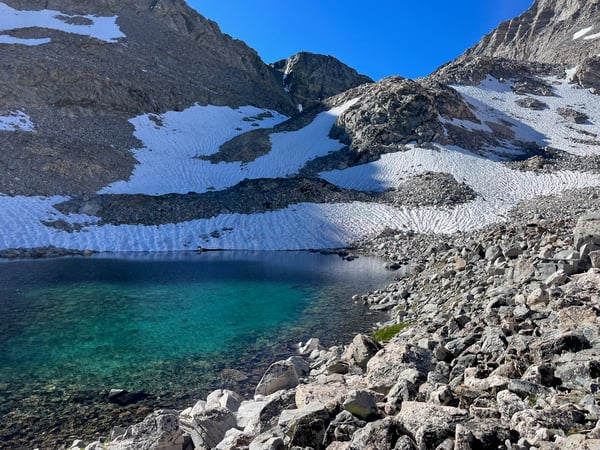
I felt inordinately triumphant as I strapped the last foam pad to the outside of my bulging “ultralight” backpack and radioed Lei that she could remain in camp. As I made my way back up the snow and slabs, I eyed the possible descent routes from the climb with suspicion. I would have to ascend one of these routes carrying everything except our climbing gear. My beta read something like “down climb the snow, or maybe rappel.” I also had some conflicting information about which gully to descend. I watched several parties coming down, and they all rappelled from rocks down the initial snow slope. I ran into a soloist we had talked to on the way up (who apparently did not remember me from that interaction), and inquired about the descent conditions. He said the “standard” descent was sketchy. I didn’t know what the standard descent was, but I figured if this guy could get down in micro-spikes I would probably be ok with my ultralight crampons.
Having a plan for the rest of the trip was somewhat of a relief, but two big unknowns still loomed over me: the route up to the ridge, and what I would find on the other side. The other side looked flat enough on a topological map, but the possibility always existed that some steep features smaller than the resolution of the map could present a problem.
After setting up our new camp, I decided to scope out the descent route in preparation for dropping off gear the next morning. First I went up what I assume to be the standard descent. A party of two had split up after rappelling down the snow from some rocks. The snow was steep enough that one of them decided to traverse over to a rock band instead of down climbing the snow. They asked me what in the world was I doing, and I said that I was scoping out the descent route for my partner who was less confident on snow, feeling particularly ridiculous about the fact that I was instead planning to ferry gear for an alternate descent. Sometimes when people hear about the crazy things I’m doing, they assume I am confused or need help. It’s kind of funny but also kind of sad. Like the soloist who warned me that we wouldn’t find a camp site higher than the lake, we when had already done just that. In retrospect, that is probably why I lied. I didn’t feel like explaining my decisions to anyone.
I started getting nervous as I kicked steps up the increasingly steep slope in my approach shoes and ultralight crampons. I had a moment of terror when my crampon popped sideways off of my shoe. My other solid crampon and ice axe placement kept me from falling, the rock above me tantalizingly close. But given the ever increasing angle of the slope, I delicately reattached my crampon and made my way back down. After down climbing a bit, I tried a second route that would avoid the snow completely. I thought there must be a reason why no one goes this way, and indeed, after padding up a fourth class slab, I reached a move that I would not solo without any weight, let alone a giant backpack. I almost gave up on the entire endeavor at this point, feeling slightly shaken from my scrambling adventure, but I decided to try one last option. I made my way much further east, crossing a questionable choss gully that one of the two descending climbers suggested I might consider as a route down. I climbed more steep snow, but I could see that the terrain leveled off in just a few moves. One more slightly sketchy snow traverse later, I had arrived at a pile of rocks that looked like it would go without too much trouble. I knew I had it in the bag at this point. But what would I find on the other side?
I popped my head over the ridge to find a low, golden sun bathing a sandy flat. Relief washed over me, and I broke into a huge smile. Lake Italy shone far below, our goal for the next night’s camp. Though I couldn’t see all the terrain separating us from the lake, at least the first section of our descent would be an easy jaunt.
I arrived back at camp very tired. Enough so that I asked Lei how badly she wanted to do the climb? At this point I felt like I’d had enough adventure already and wasn’t particularly keen on climbing the next day, especially if we could just hike out as planned. But after about 30 minutes of rest my enthusiasm returned.
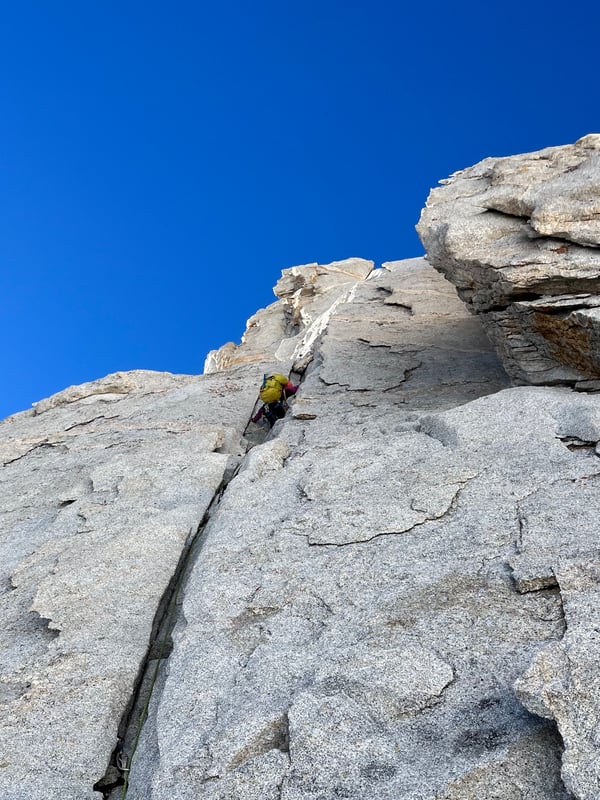
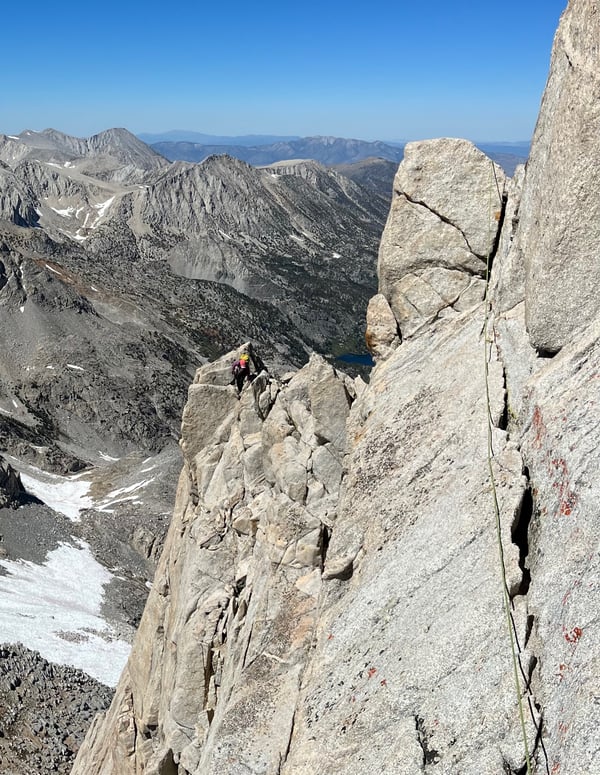
The climb was fantastic, wild, and went without incident. We were the only party on the climb that day and topped out in the mid-afternoon sunshine. Next came the part of the route that was completely unknown to us. We had to put on crampons for one snow slope below the sandy flat, but other than that the descent was little more than a walk through idyllic meadows. We arrived at the toe of Lake Italy with just enough time to set up camp and make dinner before dark. All of the parts of the trip I had worried about were done. Our next day would be long, but I figured not too strenuous since it was all on a trail.
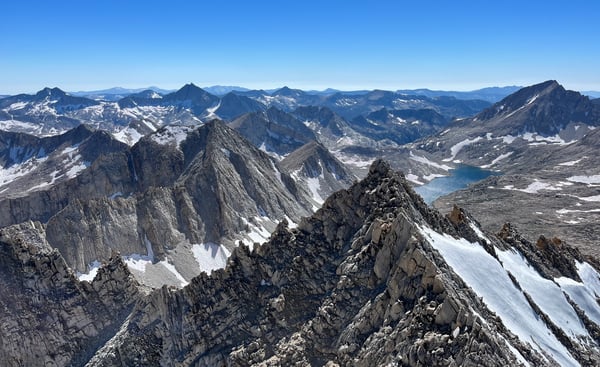
We awoke to a frosty morning, the most beautiful of my entire trip in the Sierra. It was just pure light. I wanted to stay in this morning forever, to live there, following the dirt path around the shore of Lake Italy. But we had places to be! And wow did the trail go around. Because of an impassible steep section on the east side of the lake, we had to circumnavigate almost the entire lake before intersecting with the trail up to Italy Pass. When we realized just how far we would go around, we saw that we would have to surmount a couple of large snow obstacles that extended all the way to the lake. Huge blocks of snow were calving off into the lake and the snowfields looked to be at least partially hollow underneath. We traversed the first without putting on crampons, but it was sketchy. For the second we opted to go up some slabs and around the snow. During the next mile or two, we never found a consistent trail and were mostly scrambling up and down rocks without being able to see very far ahead. I became impatient with our slow progress.
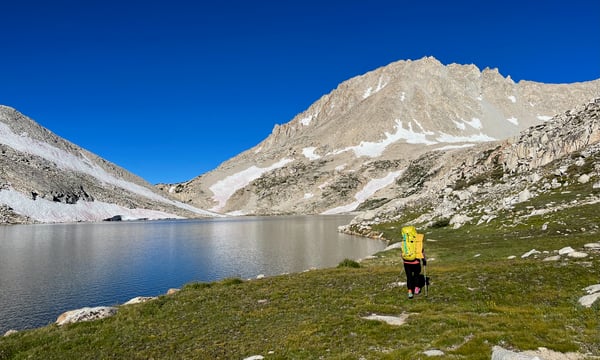
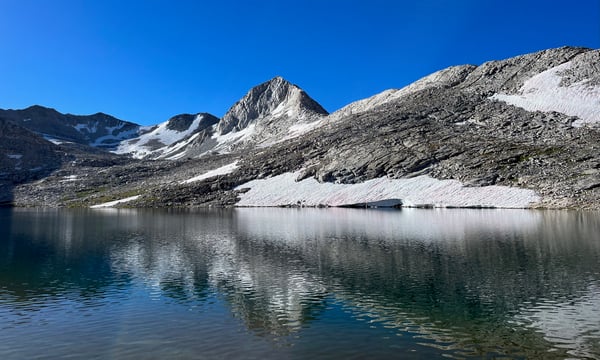
As the terrain steepened up to Italy Pass, a clear trail emerged. Our lovely morning gave way to a brutal slog in the midday sun. Finally we made it over Italy Pass, but the trail was not obvious or smooth-going until midway through Granite Park, the next relatively flat area. We were both straining under our packs that were not designed to carry this much weight. Once past Granite Park we booked it out on the trail, passing by more beautiful lakes, slabs, waterfalls, and eventually the forest. The number of people we encountered was jarring after not seeing anyone for almost two days. The last five miles or so felt unimaginably long. Surprise snowfields continued to appear, even after we were well below treeline. We arrived at the trailhead before dark but hours behind our predicted time, surprisingly exhausted after “only” 15 miles on a “trail.” The adventure was over, but I was filled with joy for days.
This trip was a test of faith, not in the spiritual sense, but a test of self-faith. I wanted to give up so many times. I’ll be honest that I didn’t have the purest of motivations. I didn’t want to let Dan down after all the work and stress of helping us with the car shuttle. I didn’t want to tell others I had failed. I didn’t want to deal with the logistics of getting back to our car from the wrong trailhead. But ultimately I wouldn’t have kept going without some measure of self-faith. I still look back on this trip for inspiration as I struggle with the very personal rejections of searching for a new job. I remember that I am more capable of overcoming challenges than I sometimes believe, than others sometimes believe. I just need a little push.
